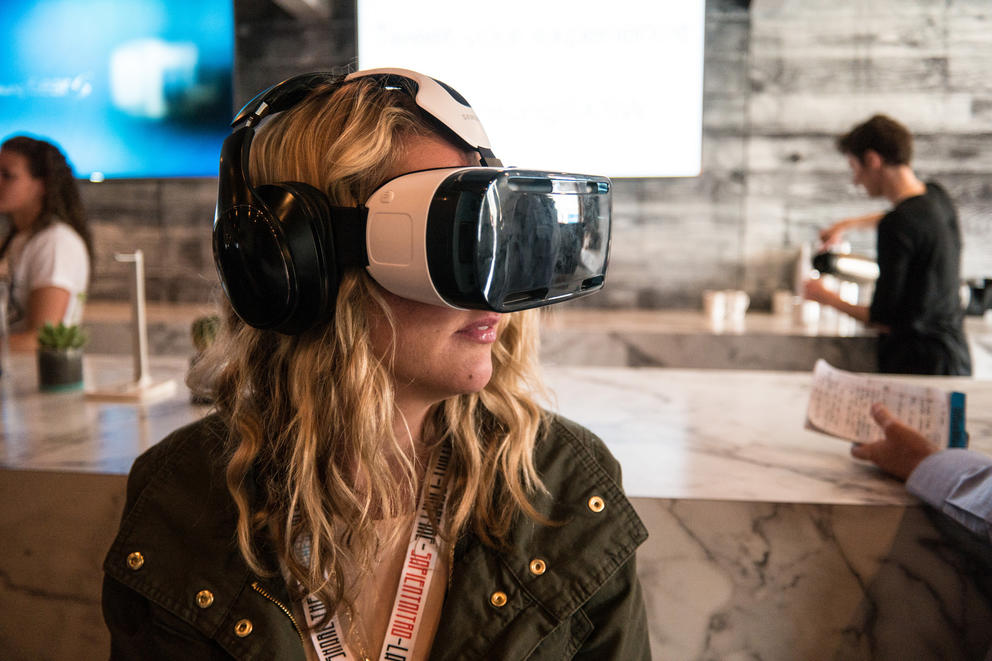I walked out of the Beijing airport last week, a bit lost. I didn’t know how to hail a cab or get help with my luggage. Luckily I had a guide to help me.
Well, I didn’t actually fly to Beijing, I arrived in China via a virtual reality simulation. And that guide? It was Amazon’s intelligent assistant Alexa, via an experimental integration between a virtual reality environment and the company’s Echo.
The Mandarin teaching experience was one of many projects developed during the 2016 Seattle VR Hackathon, where over a hundred stalwart VR developers converged to explore how they could transform the heavy headsets of Oculus Rift, the HTC Vive, Samsung Gear and the more portable Google Cardboard into something playful, productive or meaningful.
While 2016 has been touted by many as the year of VR, there is precious little software on the market to fuel the clamor for buying headsets. Apple and Android count apps in hundreds of thousands, VR currently counts them in dozens.
To be fair, it takes time for developers to figure how to leap into the virtuous cycle of a new platform. They need to figure out where they can leverage their current skills so they can create something interesting in a reasonable amount of time — and as they learn and grow more familiar with the emergent platform, they need to be open enough to the shifts in paradigm so that the platform can inspire them to develop entirely new applications, interfaces or experiences that they would never have considered before.
Thus the hackathon, which allows budding VR developers a place to explore the technology’s capabilities. It’s one of a number of events that are putting the Seattle region at the epicenter of the VR revolution – and exposing the barriers, and the opportunities, that lie ahead for this emerging technology.
* * *
Anyone looking at the hackathon’s demonstration projects would argue that VR has the potential to change some assumptions we make about how we spend our leisure time, how we socialize over the Internet and even how we work.
Take digital music. We now stream or synchronize our music with devices. Many audiophiles have pushed back against digital music because even the best copies don’t contain the richness of analog recordings. And the experience of buying music, and selecting it, is far different, and much less immersive, than a visit to Tower Records, or riffling through a friend’s box of LPs.
So one of the hackathon teams sought to engineer their way out of our overly efficient, impersonal music experience. They created a lounge with a couch. Yep, you sit on your own couch, put on a Samsung Gear VR headset, scan around the room and select a poster for a piece of music you want to hear, and it starts playing. The music sounds a bit different because the team applied filters to make the digital music lean analog. Their vision is to recreate record bins so music aficionados can peruse their platters, take out an album and place it on the turn table. They might even be able to bring the cover over to the couch and read the liner notes while they chill.
Many of the ambitious hackathon projects pointed toward innovative ways of solving old problems, like swatting bugs. One of the coolest experiences came from a project called Mosquito Disco in which a team created a simulation of a future VR-to-drone application that would help a pilot drive through actual mosquito infested lands, zapping the little blood suckers as they flew through a swarm.
Also on display was a planning application designed to help balance resources for battling disease in Africa, replacing tools like spreadsheets with visual maps that displayed how people, money, equipment and treatments were deployed. Organizers might one day be able to see gaps in coverage, or more rapidly respond to an outbreak, by dragging and dropping resources in VR.
One of the most aspiring projects of the weekend focused on recreating social media for an immersive world. The platform would allow people to post 360-degree content much as they do 2D photos and videos on Facebook or Pinterest today, but they could also stitch together experiences and develop collaborative stories by connecting content through “portals” that transport people from one 3D space to another.
If you think you get lost in Facebook’s social stream, just wait until you can actually jump through connective, immersive experiences, like say, multiple friend’s videos of the same concert. On the learning front those same multiple perspectives might be a lecture with connected real and virtual breakouts, creating the ultimate learning resource for students.
And if you need one more example of VR that will change your perspective, imagine a game that floats before you, a puzzle. Concentric spheres that need to be merged to form a larger sphere. Space becomes part of the puzzle.
* * *
Of course, every time I say imagine I do so only because you weren’t able to don a headset and experience these demonstrations for yourself. That is a huge marketing problem for VR. If potential consumers only see people in headsets gyrating to some imagined experience, they don’t get a sense for what the participant finds so intriguing. VR needs VR to make it real.
In some ways, the inexpensive Google Cardboard and its clones are a gateway to VR, but their lack of ability to track physical body position (they only track head movement,) and the consumption nature of much content available to that platform, such as watching VR movies, or just sitting through a roller coaster experience, makes them poor cousins to the interactive Vive and Rift.
The current dearth of hardware will make it difficult for people to experience VR for themselves, though Oculus has announced retail availability of the Rift, which means you may soon be able to visit a local Best Buy and try one on (this recent SteamVR featuring the HTC Vive video does as good a job as is possible to make the 3D experience accessible to 2D viewers).
The difficulty of translating experience and the scarcity of hardware means many consumers and businesses are currently asking why they need virtual reality. The hackathon provides an answer: We have reached the edge of what we can do with computers on the desktop, the laptop, even in our pockets. We live in a three-dimensional world, yet interact with it through our most powerful tools on a flat plane that never does it justice, one where our brains must make up the deficit between analysis and interpretation.
With virtual reality, computing offers an entirely new level of engagement and immersion that has been unattainable outside of research labs. As applications develop, we will no longer be asked to “imagine if a building where here,” or to “watch this PowerPoint presentation and imagine how it would feel to zap mosquitos with a drone.” With virtual reality, people will be able to walk the corridors of buildings that existed previously only as blueprints, or experience visionary projects that are barely more than ideas on a whiteboard.
Recreating what seems like a simple experience requires models of real world objects, access to databases of music, simulations of equipment and algorithms that enhance sound, animate avatars and shine lights to create atmosphere or mood, and convey information. Developers are just getting a handle on how to balance between what is real and what is imagined. The software and hardware have no problem accepting both.
Which brings me to my final point about what this revolution needs to take off: The success of VR is no longer predicated on the availability of hardware to deliver a good experience, but on people who can design one.
And that is where Seattle shines as a multidisciplinary hub for artists, programmers, gamers, storytellers and new emergent roles that synthesize among those to become world and character designers. Schools like the University of Washington and Redmond’s Digipen cultivate the currently scarce talent necessary to transform VR from an interesting curiosity into a necessary, mainstream tool.
A sad sign at the hackathon emphasized the scarcity of talent, even in a room full of talented individuals. The sign read: “3D digital artist needed.” The team of programmers never found their visual muse.
* * *
At the University of Washington, VR pioneer Tom Furness, known in some circles as the “grandfather of VR” is trying to solve that problem. He brought his Department of Defense experience to the Northwest in 1989 when he founded the HITLab. From his experience inventing heads-up displays and advanced simulations, he and his students have quietly nurtured a revolution.
Furness says of the hackathon developers: “They are approaching VR as a general, problem-solving platform. It really is that. We’ve spent so much time over the past several decades reducing our world to tables of data. With VR we can bring back spatial elements, size and shape and location, and of course physics, so we can make computing more natural and aligned with how our brains perceive the world.”
For those who haven’t experienced VR yet, you are missing out. While it isn’t perfect, if you get connected to the right application, it delivers an amazing experience that quickly tricks your brain into believing you are in a different place, or even different time (perhaps different universe).
VR is going to create new jobs for our eclectic Seattle talent pool, and eventually it’s going to change our relationship with technology. We are on the verge of a shift where two dimensions will no longer suffice. All of the desk space taken up by big monitors, laptop computers and peripherals will give way to even larger virtual monitors projected into 3D-space and sitting inside worlds that manage our communications, enhance our productivity and give us new ways to explore our fantasies or learn new skills (yes, one more thing to imagine, chucking all that desk clutter in favor of a VR workspace).
And every few months, a group of really bright people get together in Seattle to wield their digital machetes (development tools) with names like Unity, Unreal and C#, and hack the way to VR as a computing reality.


